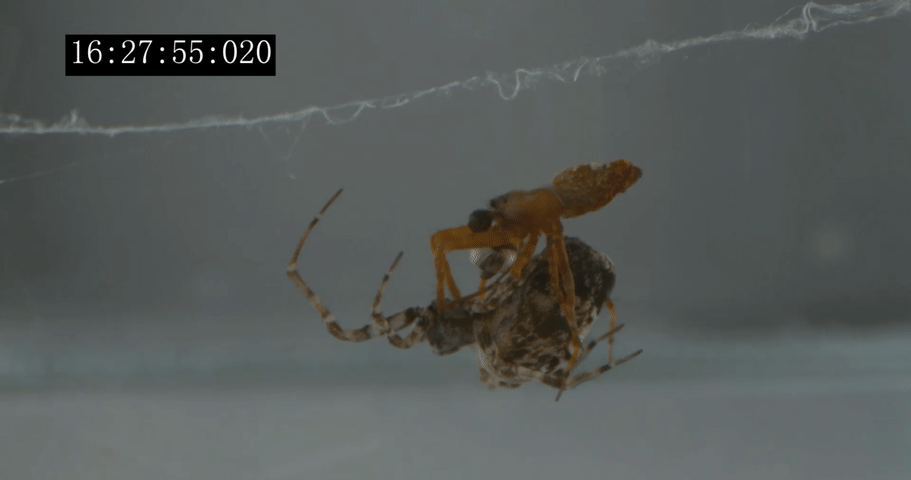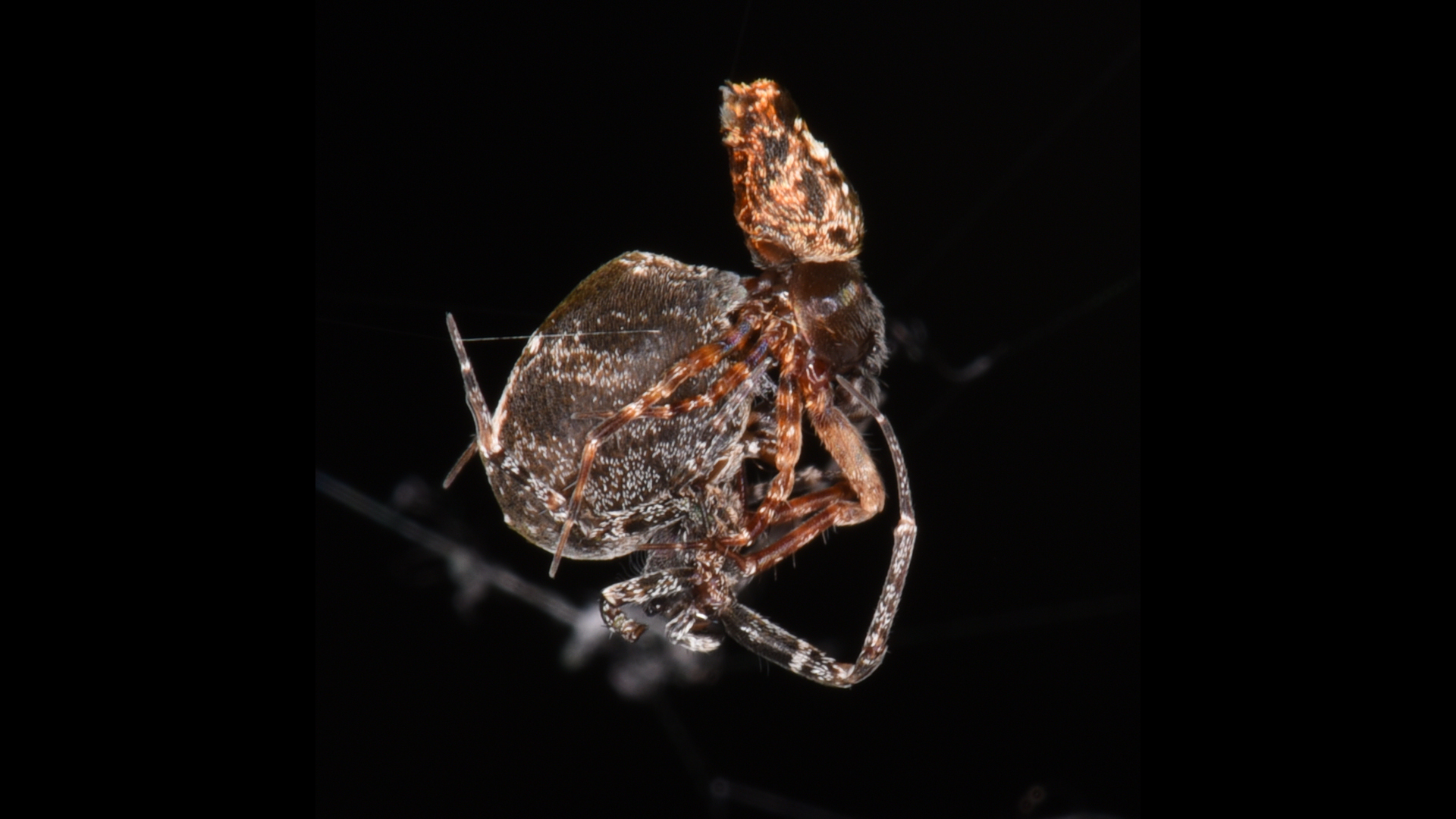These male spiders use built-in leg catapults to escape sexual cannibalism
After mating, males gotta bounce.

For a type of orb-weaving spider, mating has a spectacular finale: The male catapults off a female's body at a speed too fast for a human to see with the naked eye.
These amorous acrobatics aren't meant to impress the spiders' partners; rather, a male springs into action to escape the female's hungry mandibles, as sexual encounters for these arachnids would otherwise end with the male being eaten.
They leap for their lives by using a mechanism that has never been seen before in spiders, involving a joint in their front legs that enables them to launch their bodies dozens of centimeters in a split-second by storing kinetic energy and then suddenly releasing it, according to a new study.
Prior to mating, male spiders would secure themselves to the female's web with a silk "safety line," so that after catapulting they could climb back up to mate again. Males sometimes mated with the same female up to five times; and with the risk of being cannibalized looming in every encounter, post-sex catapulting likely evolved as a means of survival, the researchers reported.
Philoponella prominens spiders are tiny — males' bodies measure about 0.1 inches (3 millimeters) long, while females are about twice that size — and they live in colonies that can contain more than 200 spiders in a vast network of webs. When the study authors observed a colony of the orb-weavers in Wuhan, China, in 2019, they noticed that mating always ended with the males catapulting off the females so quickly "that common cameras could not record the details," said Shichang Zhang, lead author of the study and an associate professor at Hubei University's School of Live Sciences in Wuhan. That prompted the researchers to take a closer look at what was going on while the spiders were mating, Zhang told Live Science in an email.
Related: Weird and wonderful: 9 bizarre spiders
But taking a closer look turned out to be exceptionally challenging. Because the spiders were so small and mating was over so rapidly (lasting only about 30 seconds from copulation to catapult), the study authors struggled to focus their high-speed camera's macro lens in time to film the mating act and its aftermath. In many cases, the males finished and sprang away before the camera lens was focused and ready.
Sign up for the Live Science daily newsletter now
Get the world’s most fascinating discoveries delivered straight to your inbox.
"That's the most difficult part in this research," Zhang said.
The scientists collected around 600 P. prominens spiders and conducted 155 successful mating trials. In spite of the photography challenges posed by the speedy spiders, the researchers captured images with a camera shooting 1,500 frames per second, and then used software to measure the energy and speed of the male spiders' catapulting escapes. After the first mating, 97% of the males catapulted — and all of them survived. Males that failed to catapult "were captured, killed and consumed by the females," the study authors reported. When the scientists prevented 30 males from springing away by disrupting the catapult mechanism in the spiders' legs, all of those males were also devoured.

But when the spiders were able to fling themselves away, the stored energy in their legs propelled their tiny bodies at remarkable speeds: up to 2.9 feet per second (88 centimeters per second). That's the equivalent of an adult human taking a flying leap and landing one second later at a distance of nearly 1,740 feet (530 meters), Zhang said.
"We hypothesized that the mechanism of the catapulting is that the legs are folded against the female, and then when released the hydraulic pressure causes the legs to rapidly expand," the scientists reported.
Similar mechanisms using hydraulic energy storage and release for rapid limb movement are found in other animals, such as the mantis shrimp's knockout punch and the blink-and-you'll-miss-it speedy snap of a trap-jaw ant's mandibles. "But they use the fast actions to either capture prey or escape predators," Zhang said. By comparison, the wee orb-weavers are the only known animals to use the technique as protection against sexual cannibalism, catapulting to safety so that they may live to mate another day.
This could be a way for the males to signal their fitness as mates, as males that are physically superior to their competitors can perform multiple catapults while mating, "thereby increasing their chance of paternity," the study authors concluded.
The findings were published April 25 in the journal Current Biology.
Originally published on Live Science.

Mindy Weisberger is an editor at Scholastic and a former Live Science channel editor and senior writer. She has reported on general science, covering climate change, paleontology, biology and space. Mindy studied film at Columbia University; prior to Live Science she produced, wrote and directed media for the American Museum of Natural History in New York City. Her videos about dinosaurs, astrophysics, biodiversity and evolution appear in museums and science centers worldwide, earning awards such as the CINE Golden Eagle and the Communicator Award of Excellence. Her writing has also appeared in Scientific American, The Washington Post and How It Works Magazine. Her book "Rise of the Zombie Bugs: The Surprising Science of Parasitic Mind Control" will be published in spring 2025 by Johns Hopkins University Press.










